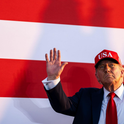There are three perches from which to consider Iran right now. One, after the Tehran suicide attacks on 7th June, is as a bloodied victim of Islamic State terror. Another is Iran the resurgent Shia superpower, using the easing of sanctions and the liberation of $100bn worth of overseas assets to project its power across the region. The third was glimpsed recently when Iranians re-elected reformer Hassan Rouhani as president, who said in his victory speech that Iran was “ready to develop its relations with the world.”
How do western legislators empathise with the “victim” Iran while maintaining that it is a state sponsor of terror? And how do they deal with the expansionist, theocratic Iran—accused of fomenting that terror—while trying not to disinhibit the reformers? In 2013, European governments and the Obama administration decided to break with the past and reach out to Tehran, hoping to ameliorate hostilities so old they had calcified. The result was the nuclear deal of 2015, which Israel’s Prime Minister Benjamin Netanyahu called a “historic mistake,” and Donald Trump called “the worst deal ever negotiated.”
As president, Trump and his administration have continued this stance. On 20th May, Secretary of State Rex Tillerson called for an end to Iran’s ballistic missile testing. In Jeddah, during his trip to the Middle East, Trump proposed an Islamic coalition to thwart terrorism and described Iran as “the government that gives terrorists… safe harbor, financial backing.” Later, in Israel, he vowed to confront “Iranian regime that is … causing so much violence and suffering.” And of course, he Tweeted support for the isolation of Qatar, hoping, among other things, to break its tilt towards Iran. Most recently, while Trump offered to “grieve and pray” for the victims of the Tehran attacks, he added that “states that sponsor terrorism risk falling victim to the evil they promote.” This statement was dubbed “repugnant” by Iran’s foreign minister.
None of this feels like the work of a populist insurgent who is “draining the swamp.” It is more like a reheat of the George W Bush years—even though that administration’s Iranian policy is now widely regarded as a low watermark. Bush failed to engage with a nascent reform movement that was manifest in its effort to consolidate a fractious Afghan opposition at the Bonn Conference in December 2001. At Bonn, and shortly after, Iran went out of its way to shoo in US-leaning wild-card Hamid Karzai as president of the new Afghanistan.
"After the Tehran attacks, Trump said that 'states that sponsor terrorism risk falling victim to the evil they promote.' This statement was dubbed 'repugnant' by Iran’s foreign minister"In 2001 and 2002, Iran then passed intelligence on Taliban positions to diplomats and the CIA, becoming a covert supporter of the war. It went on to expose Pakistani collaboration with the Taliban and Al Qaeda, offering the US assistance in capturing fighters and leaders in an unprecedented rapprochement. The Bush administration responded by, immediately after Bonn, hedging against Iran by sending staff to Italy to fund and arm cells of the MeK, the exiled opposition group that aimed to topple the regime in Tehran. And then in January 2002, Bush stunned his envoys and State Department old hands with a State of the Union address that lumped Iran in with outlaw states as part of the “Axis of Evil.”
The repercussions of not recognising the layers of power in Iran were massive. Our new book The Exile is based on a trove of interviews, letters and communiqués from Al Qaeda, as well as first-hand interviews with members of its religious and military councils and Osama bin Laden’s family, in the largest deep dive ever undertaken inside a paranoiac terror outfit. An extraordinary picture emerges. In the weeks immediately after 9/11, American missiles were falling on Afghanistan and Al Qaeda was on the ropes. Osama’s spiritual adviser, a Mauritanian religious scholar called Mahfouz Ibn El Waleed, was dispatched to find a new headquarters. A critical figure on Osama’s ruling council, El Waleed has said in recent interviews: “We hoped Iran would offer us a protective bubble that roving US forces dared not penetrate.”
El Waleed left for the Iranian border at Taftan on 19th December 2001, seeking out Major General Qassem Suleimani, commander of Iran’s Quds Force and an influential ofcer who handled Tehran’s covert foreign policy interests. After the Bush address rang in everyone’s ears, Suleimani decided to back a plan and enabled the Al Qaeda exodus to begin in March 2002. Quds Force agents set up a desert refugee camp on the Afghan border, funnelling women and children to the four-star Howeyzeh Hotel on Tehran’s Taleqani Street. Meanwhile male fighters were put up at the Amir Hotel—and all of them were then issued with bogus papers before being dispersed on ights to southeast Asia, Syria, Jordan and Lebanon.
Osama’s family and several high-ranking Al Qaeda leaders including Saif al-Adel, the Egyptian military chief on the FBI’s Most Wanted Terrorists list, arrived in Iran that year. They set about reforming the outfit’s leadership council in Mashhad, Iran’s second largest city, before moving inside the Quds Force base in Tehran. Their letters show how they established a funding pipeline through Iran and began plotting new attacks, including the Riyadh compound suicide bombings of 2003 in which 39 were killed.
"George W Bush’s experience reveals that ostracising Tehran enabled a terrorist movement to be nurtured within it"Iranian modernisers rallied again and reached out to the Bush administration in 2003, offering up a large chunk of the Al Qaeda leadership and most of bin Laden’s family—enough to stymie the outfit and likely winkle out Osama himself. The deal was rejected outright by the White House. The naysayers were led by Vice President Dick Cheney, who argued that after the ousting of Saddam, Iran would be next on the Pentagon list.
The refusal to agree a deal with Tehran enabled Al Qaeda to reform and prosper, costing countless lives. It would be another eight years before bin Laden would be run to ground in Abbottabad. But the story did not end there. Many of Al Qaeda’s leaders remained in Iran for more than a decade. Finally, in summer 2015, four of the military council were secretly flown to Damascus by the Quds Force. In 2016, after 13 years in Iran, military chief Saif al-Adel was quietly taken to Syria, where he remains. Evidence has recently emerged that Dr Ayman al-Zawahiri, Al Qaeda’s leader, may also be in Iran. The country continues to protect the in-laws of Hamzah bin Laden, one of Osama’s sons. Last week, Hamzah issued his latest pronouncement, encouraging lone-wolf style attacks against the west in a campaign entitled: “We Are All Osama.”
Back in February, Trump railed on Twitter that Iran did not appreciate how “kind” President Obama was to them. “Not me!” he promised. But George W Bush’s experience reveals that ostracising Tehran enabled a terrorist movement to be nurtured within it—and the elevation of hardliner Mahmood Ahmadinejad to the presidency. What will be the price of Trump’s cold shoulder?
The Exile – The Flight of Osama bin Laden, (Bloomsbury)












